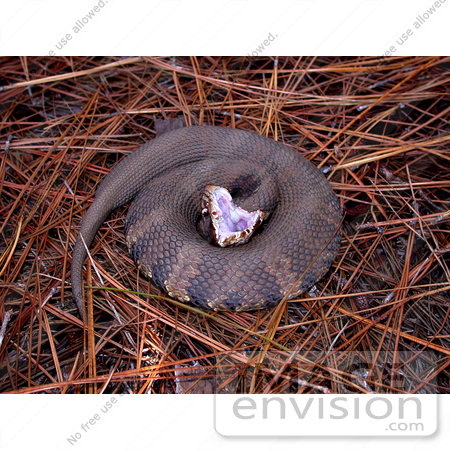|
Picture of an “eastern cottonmouth” snake, Agkistrodon p. piscivorus, as it was coiled atop a ground cover of pine needles. Startled, this snake had taken on a defensive posture, bearing its fangs in a very aggressive manner. When one thinks about snakes indigenous to the hurricane prone areas in the southeastern United States, the cottonmouths or water moccasins are probably the first snakes to come to mind, which is of importance to those who either live in these regions, or who might be deployed to such areas as a first-responder offering aid to those affected by such a disaster. The cottonmouths are large, dark, heavy-bodied snakes, and are the largest snakes in the New World Agkistrodon species complex, and are the only members of the group that are semiaquatic (Gloyd and Conant, 1990). The eastern cottonmouth inhabits the southeastern quadrant of the United States, extending from the Great Dismal Swamp in extreme southeastern Virginia, southward along the Atlantic Coast to the level of central Georgia, and westward through Alabama into the northeastern corner of Mississippi (Gloyd and Conant, 1990). The eastern cottonmouth is one of the most colorful subspecies, and is readily distinguished from the “Florida” specie, A. piscivorus conanti, by the lack of the dark vertical markings on its rostrum, and differentiated from the “western” specie, A. piscivorus leucostoma, by the presence of conspicuous stripes on the lateral head that are usually visible even in older adults, as was the case in this specimen. The body profile of A. piscivorus piscivorus is often somewhat more triangular than other two subspecies, most notably on its anterior body. This image was created in 2005 and provided by the Centers for Disease Control and Prevention/Edward J. Wozniak D.V.M., Ph.D., John Willson at the University of Georgia, at the Savannah River Ecology Laboratory (SREL). [0003-0702-0313-4424] by 0003
|







